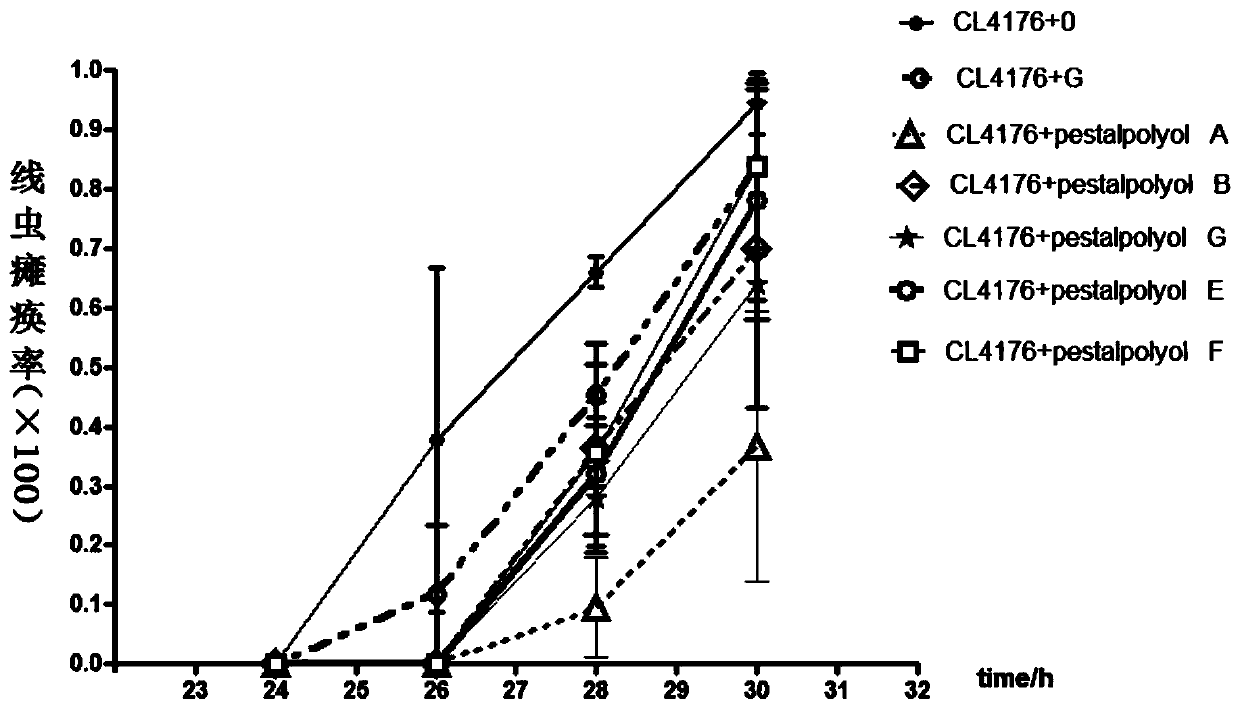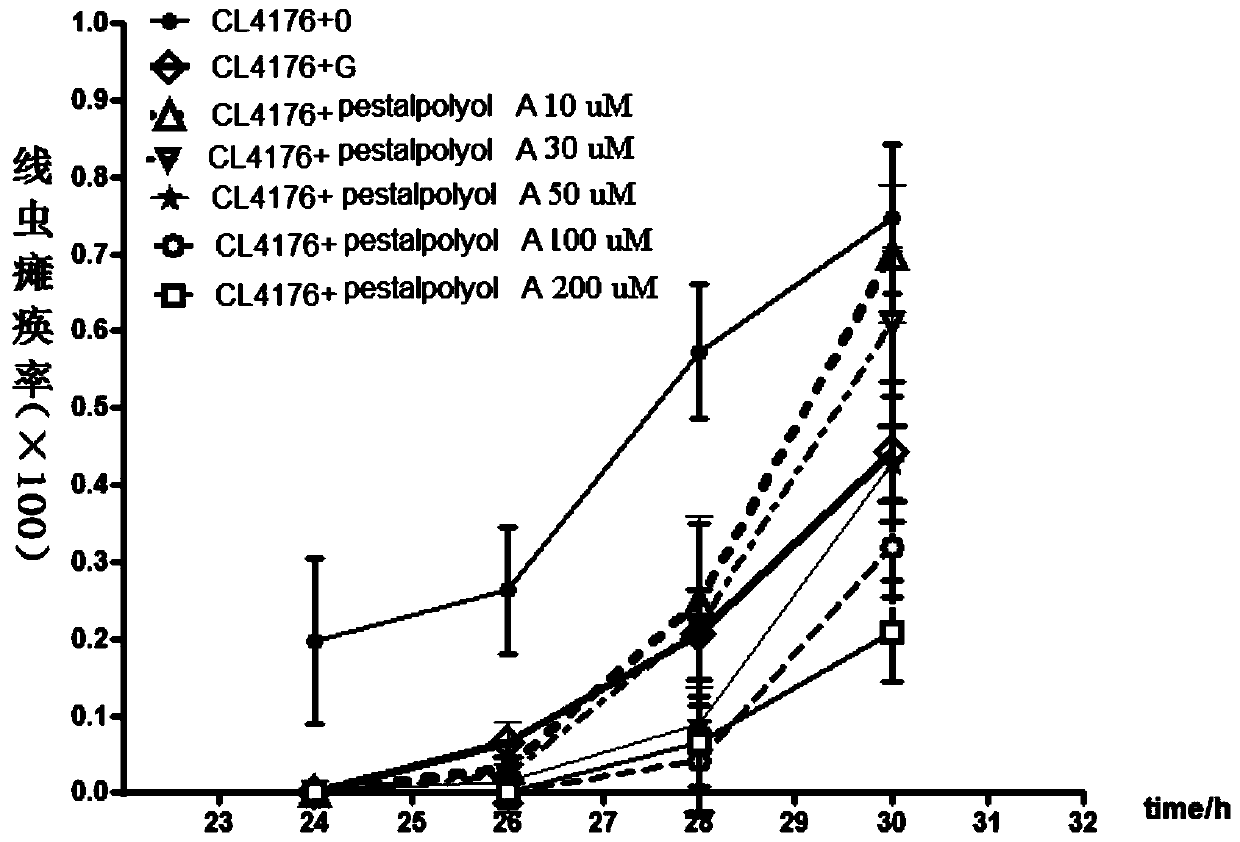Application of polyketide compound pestalpolyol A as a drug for the treatment of Alzheimer's disease
A technology of Alzheimer's disease and polyketide compounds, which is applied in the application of drugs for the treatment of Alzheimer's disease. , the effect of simple structure
- Summary
- Abstract
- Description
- Claims
- Application Information
AI Technical Summary
Problems solved by technology
Method used
Image
Examples
Embodiment 1
[0013] Example 1 Screening of Compounds Effective on Alzheimer's Disease Model Nematode Strain CL4176
[0014] (1) Cultivate the Alzheimer's disease model nematode strain CL4176 on a medium covered with E. coli OP50, in a constant temperature incubator at 15°C for about 3-4 days, observe that most nematodes start to lay eggs and then synchronize change.
[0015] (2) After the worms in step (1) were synchronized, they were cultured in a constant temperature incubator at 15°C for 48 hours to hatch L1.
[0016] (3) Prepare a Petri dish containing NGM. Add 30 μM of pestalpolyol A and its structural analogues pestalpolyol B, pestalpolyol G, pestalpolyol E, and pestalpolyol F to 200 μL each and dry, then add 200 μl of E.coli OP50 to dry and place in a constant temperature incubator at 37°C for overnight culture. A blank control group was set up for each experiment, that is, only 200 μL of solvent acetone and 200 μL E.coli OP50 were added, and a positive control group was 200 μL of...
Embodiment 2
[0022] Example 2 Different concentrations of pestalpolyol A in the treatment of Alzheimer's disease
[0023] (1) Cultivate CL4176 nematodes on a medium covered with OP50 in a constant temperature incubator at 15°C for about 3-4 days, observe that most of the nematodes begin to lay eggs and then synchronize.
[0024] (2) After the worms in step (1) were synchronized, they were cultured in a constant temperature incubator at 15°C for 48 hours to hatch L1.
[0025] (3) Prepare a petri dish containing NGM, add 200 μL of compound pestalpolyol A with a concentration of 10, 30, 50, 100, 200, 300, and 500 μM respectively and dry it, then add 200 μL of E.coli OP50 to dry it and place it at 37 Cultivate overnight in a constant temperature incubator. A blank control group (only 200 μL of solvent acetone and 200 μL of E.coli OP50) and a positive control group (200 μL of 30 μM Galantamine and 200 μL of E.coli OP50) were set for each experiment, and each experiment was performed in triplic...
Embodiment 3
[0031] Example 3 Cytotoxicity detection of polyketide compound pestalpolyol A
[0032] MTT method:
[0033] (1) Collect the logarithmic phase cells, add 100 μL of cell suspension to each well of the 3-10 column of the 96-well cell plate, plate and adjust the cell density to 10 4 Add 100 μL of cell-free medium to the 2nd and 11th columns of the well plate, and fill the 1st and 12th columns of the well plate with 100 μL of sterile PBS.
[0034] (2) 5%CO 2 , and incubated at 37°C until the cell monolayer covered the bottom of the 96-well cell plate. Drugs can be added after the cells adhere to the wall. In this experiment, the plates were plated in the afternoon before the drug addition, and the drugs were added in the morning of the next day. Add 10 μM drug to column 3 and 4, add 30 μM drug to column 5 and 6, add 50 μM drug to column 7 and 8, 10 μL per well, and set 16 replicate wells.
[0035] (3) 5%CO 2 , incubated at 37°C for 48 hours, and observed under an inverted micr...
PUM
 Login to View More
Login to View More Abstract
Description
Claims
Application Information
 Login to View More
Login to View More - Generate Ideas
- Intellectual Property
- Life Sciences
- Materials
- Tech Scout
- Unparalleled Data Quality
- Higher Quality Content
- 60% Fewer Hallucinations
Browse by: Latest US Patents, China's latest patents, Technical Efficacy Thesaurus, Application Domain, Technology Topic, Popular Technical Reports.
© 2025 PatSnap. All rights reserved.Legal|Privacy policy|Modern Slavery Act Transparency Statement|Sitemap|About US| Contact US: help@patsnap.com



